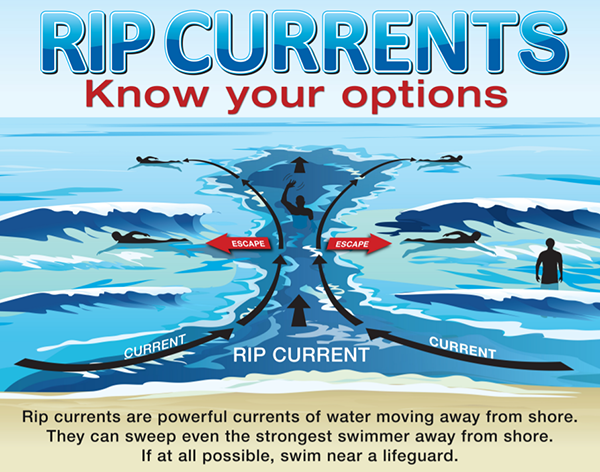Your Outer Banks vacation should be great experience where you return year after year and make the best memories. Therefore, before you hit the beach, it's important that you educate yourself on rip currents and learn about practicing ocean safety.
What are Rip Currents?
Rip currents can occur at any beach with breaking waves and most often form at low spots or breaks in sandbars and near structures like piers, jetties and groins. The National Oceanic and Atmospheric Administration (NOAA) officially defines rip currents as “a localized current that flows away from the shoreline toward the ocean, perpendicular or at an acute angle to the shoreline.” In other words, rip currents are fast-moving currents of water that can pull even the strongest swimmer away from the shore. In fact, some rip currents have been measured to reach speeds of up to 8-feet per second, though most are typically at around 1 to 2-feet which is still fast enough to quickly pull a swimmer away from the shore.
According to the U.S. Lifesaving Association (USLA), more than 80 percent of the surf beach rescues performed by lifeguards each year involve rip currents and they account for at least 100 deaths each year at U.S. surf beaches. So how can you protect yourself?
Check Local Conditions Before Swimming
Although beaches along the US coast all have their own methods of warning visitors of potentially dangerous currents, towns in the Outer Banks take heavy precaution due to the frequency of rips in the area. Before you pack your beach bags and head down to the sand for the day, take these steps:
- Check the local rip current forecast through the National Weather Service. Their website will let you zoom in to specific areas along the NC coast to check if there is a low, moderate, or high risk of rip currents.
- Look for red flags. Just because the sky is blue and sunny doesn't mean the ocean is safe. If you see a red "No Swimming" sign on the beach, do not get in the water! This could mean that rip currents have been identified or are extremely likely or even that the ocean is just too rough for swimming.
- Register for Dare County Emergency Alerts. Keep up to date with potentially dangerous weather conditions with Dare County's Emergency Management text/phone alert system.
- Learn to identify rip currents. They are not always easy to identify, but signs of rip currents include a break in the pattern of incoming waves; a channel of churning, choppy water; an area with a noticeably different water color; and a line of foam, seaweed or debris moving steadily seaward.
- Know how to swim never swim alone. The ocean is not like a pool or lake and the ocean along the NC Coast is very different than in other beaches you might have visited in the past. Respect the ocean and understand that it can be just as dangerous as it is beautiful. Never venture into the ocean alone and make sure you know how to swim.
- Swim near a lifeguard when possible. Outer Banks lifeguards are trained how to perform rescues in local water conditions which can shift quickly. Dare County's website has a complete and updated list of all beach accesses with lifeguards during the season. Also, make sure that you know your location before you head out on the beach, especially if you are not near a lifeguard. In the event that you need to call 911, emergency services will need to be able to find you quickly. If you are located on the oceanfront, be sure to know your home's address. If you've parked or walked to a beach access, know the name of the access or a nearby street. Be sure that you can describe if you have walked north or south of that access once you actually hit the beach. In the event of an emergency, every second matters.
What If You Get Caught In A Rip Current?
Despite a growing awareness of rip currents and an improvement in forecasting technology, rip currents can happen anytime and you may find yourself caught in one. Learning about rip currents and being aware of what is happening can help keep you safe. Even though it's a completely natural reaction to be scared if you find yourself being pushed away from the shore or unable to touch the bottom of the ocean floor, don't panic! A rip current is only so long and so wide—something you can escape from yourself or with someone else's help. Trouble happens when swimmers try to swim back to shore and exhaust themselves. No matter how strong of a swimmer you are, you won't be able to fight a rip current and trying will quickly exert all your energy and escalate the situation. Per the latest rip current safety guidelines:
- Don't panic—rip currents pull you away from the shoreline, but they do not pull you under.
- Don't swim against the current. Instead, swim parallel/horizontal to the shoreline until you are out of the current, and only then try to return to shore.
- If you are unable to escape the current, draw attention to yourself by waving or yelling while you steadily float/tread water.
- If you spot someone caught in a rip current, alert a lifeguard for help and call 911. If possible, throw a flotation device to the person caught in the current. If you are not properly trained in ocean rescue, you could easily get caught in the current and need rescuing yourself. If you do have to get in the water, never enter without a flotation device.
To learn more, watch these short videos and view the NOAA infographic below. To further your education about rip currents, check out this YouTube playlist from the National Weather Service with over 30 videos on identifying and surviving rip currents.





